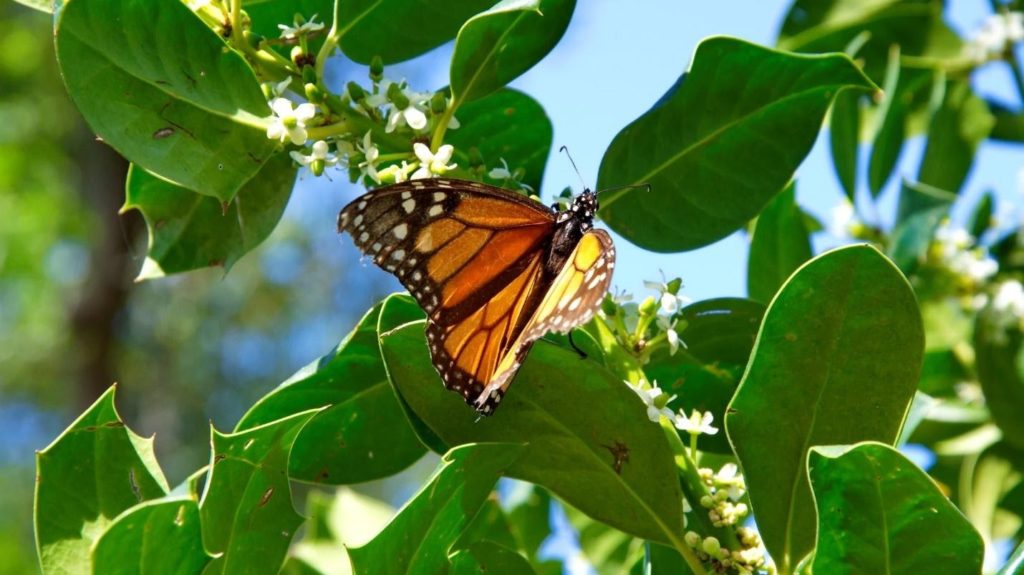Pest management is a necessary part of agriculture. Farmers have to evaluate their situation and set a pest management strategy that best serves their operations. Usings integrated pest management (IPM), farmers can manage insect pests, weeds, and diseases, and support nearby conservation efforts for the monarch butterfly and bees s IPM can be used to determine if pests are reaching economically damaging levels that require pesticide applications or other pest management measures. If pesticide applications are needed, careful attention to label warning statements, use instructions and spray drift mitigation measures can reduce off-site movement of product to neighboring conservation habitat and non-target organisms.

The NRCS Standard Pest Management Conservation System sets criteria farmers can follow to develop an IPM decision-making process that considers both pest and environmental impacts. Among the criteria suggested to mitigate the effects of pesticides to monarchs and other pollinators include adapting the system for the specific crop or crop rotation in a specific location and adhering to warnings and instructions on the label and applicable local government standards. It also recommends using science-based standards appropriate for the crop and the region as well as identifying target pests including plants, insects, and diseases. By doing so, you can obtain information on their life cycles and natural enemies in the impacted area that should be considered in any pest management approach.
Recently, we caught up with Mike VanAgtmael, an apple farmer in Hart, Michigan who highlights some of his approaches to IPM.
-
- Scout regularly: Ensure that you are only treating crops when they meet or exceed the recommended thresholds and avoid applying based only on a calendar year schedule.
- Choose appropriate pesticides: Talk to your local Extension office and other pesticide advisors and look for chemistries that have lower residual toxicity to bees, look for and understand the Environmental Warning Statements and Bee Hazard icons on pesticide labels.
- Understand pollinator habits: Pollinators are most at risk from pesticides applied to crops or other plants that are blooming. Before applying pesticides, be aware of the crop’s bloom stage, neighboring bee hives and nearby pollinator habitat.
- Minimize spray drift
-
- Evaluate the weather: To reduce drift on nearby habitat, avoid applying pesticides during temperature inversions; assess wind speed and direction to avoid drift.
- Nozzle selection: Be sure nozzles are calibrated and follow the label’s spray drift mitigation measures, which can include specified nozzles, including drift reduction nozzles; nozzle settings; use of drift-reduction agents; and other instructions. In general, larger droplet sizes are less prone to drift, so when allowed by label, consider increasing droplet size for application.
- Buffer zones: Check the label – some pesticide labels require spray drift buffers beyond the treated field that are designated to minimize pesticide exposure to sensitive sites, including pollinator habitat.
The BeSure! campaign from Growing Matters, an initiative created to support growers and applicators in protecting bees and other wildlife, provides numerous resources for good stewardship detailed in a guide called the Insect Pollinators and Pesticide Product Stewardship guide. It provides a checklist growers can follow to exercise appropriate pesticide stewardship. That checklist includes:
- Read and follow the pesticide label and use products wisely.
- Determine if the pesticide may be harmful to insect pollinators.
- Understand insect pollinator visitation habits.
- Use Integrated Pest Management (IPM).
- Follow pesticide product stewardship practices.
- Cooperate and communicate in a timely manner with stakeholders in the area of a pesticide application.
- Understand the signs of pesticide exposure to bees and other disorders that may cause similar effects.
- Check state and local ordinances pertaining to insect pollinators.
Aerial applicators also play a critical role in pesticide stewardship. To train pilots how to prevent pesticide drift, the National Agricultural Aviation Association (NAAA), an organization of professional aerial applicators and pilots, developed Operation S.A.F.E. (Self-regulating Application and Flight Efficiency). Operation S.A.F.E. is a comprehensive program of education and professional analysis, and gives the operator and pilot the tools to improve performance and reduce pesticide drift. Hear more from one member of the NAAA about how aerial applicators protect pollinators when spraying in the video below.
It’s Pollinator Week!
The release of this post comes as Farmers for Monarchs commemorates National Pollinator Week. In 2007, Congress designated the third week in June as National Pollinator Week. Pollinator Week has since grown into an international celebration, promoting the valuable ecosystem services provided by bees, birds, butterflies, bats and beetles. So this week and every week, please follow the guidance we provide in this post on pesticides and the many other practices included on the Farmers for Monarchs website.
